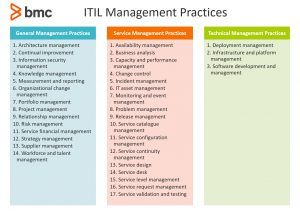Management practices make up another core component of the ITIL® 4 Service Value System (SVS). In ITIL, a management practice is a set of organizational resources designed for performing work or accomplishing an objective.
Previous ITIL versions focus on processes. ITIL 4 shifts to a focus on practices, giving the organization more flexibility to:
- Implement specific processes that are closely aligned to the specific needs of their customers
- Innovate new processes to embrace modern ways of working such as DevOps
This article explores the management practices of ITIL 4. This article is also part of our ITIL 4 Guide, which you can navigate using the right-hand menu.
Download Now: ITIL 4 Best Practice e-Books
These all-new for 2020 ITIL e-books highlight important elements of ITIL 4 best practices. Quickly understand key changes and actionable concepts, written by ITIL 4 contributors.

The origins of the practices are as follows:
- General Management Practices have been adopted and adapted for service management from general business management domains (14 domains).
- Service Management Practices have been developed in service management and ITSM industries (17 domains).
- Technical Management Practices have been adapted from technology management domains for service management purposes by expanding or shifting their focus from technology solutions to IT services (3 domains).
The 34 practices are listed below:
| General Management Practices |
|
| Service Management Practices |
|
| Technical Management Practices |
|
Let’s look at the purpose of each management practice. More details about management practices will be found in later articles, particularly focused on how they relate with the service value chain activities.
General Management Practices
| Practice | Purpose |
| 1. Architecture management | To provide an understanding of all the different elements that make up an organization and how those elements interrelate, enabling the organization to effectively achieve its current and future objectives. It provides the principles, standards, and tools that enable an organization to manage complex change in a structured and agile way. |
| 2. Continual improvement | To align the organization’s practices and services with changing business needs through the ongoing identification and improvement of services, service components, practices, or any element involved in the efficient and effective management of products and services. |
| 3. Information security management | To protect the information needed by the organization to conduct its business. This includes understanding and managing risks to the confidentiality, integrity, and availability of information, as well as other aspects of information security such as authentication and non-repudiation. |
| 4. Knowledge management | To maintain and improve the effective, efficient, and convenient use of information and knowledge across the organization. |
| 5. Measurement and reporting | To support good decision-making and continual improvement by decreasing the levels of uncertainty. This is achieved through the collection of relevant data on various managed objects and the valid assessment of this data in an appropriate context. |
| 6. Organizational change management | To ensure that changes in an organization are smoothly and successfully implemented, and that lasting benefits are achieved by managing the human aspects of the changes. |
| 7. Portfolio management | To ensure that the organization has the right mix of programs, projects, products, and services to execute the organization’s strategy within its funding and resource constraints. |
| 8. Project management | To ensure that all projects in the organization are successfully delivered. This is achieved by planning, delegating, monitoring, and maintaining control of all aspects of a project, and keeping the motivation of the people involved. |
| 9. Relationship management | To establish and nurture the links between the organization and its stakeholders at strategic and tactical levels. It includes the identification, analysis, monitoring, and continual improvement of relationships with and between stakeholders. |
| 10. Risk management | To ensure that the organization understands and effectively handles risks. Managing risk is essential to ensuring the ongoing sustainability of an organization and creating value for its customers. |
| 11. Service financial management | To support the organization’s strategies and plans for service management by ensuring that the organization’s financial resources and investments are being used effectively. |
| 12. Strategy management | To formulate the goals of the organization and adopt the courses of action and allocation of resources necessary for achieving those goals. Strategy management establishes the organization’s direction, focuses effort, defines or clarifies the organization’s priorities, and provides consistency or guidance in response to the environment. |
| 13. Supplier management | To ensure that the organization’s suppliers and their performances are managed appropriately to support the seamless provision of quality products and services. This includes creating closer, more collaborative relationships with key suppliers to uncover and realize new value and reduce the risk of failure. |
| 14. Workforce and talent management | To ensure that the organization has the right people with the appropriate skills and knowledge and in the correct roles to support its business objectives through planning, recruitment, onboarding, learning and development, performance measurement, and succession planning activities. |
Service Management Practices
| Practice | Purpose |
| 1. Availability management | To ensure that services deliver agreed levels of availability to meet the needs of customers and users. |
| 2. Business analysis | To analyze a business or some element of it, define its associated needs, and recommend solutions to address these needs and/or solve a business problem, which must facilitate value creation for stakeholders. |
| 3. Capacity and performance management | To ensure that services achieve agreed and expected performance, satisfying current and future demand in a cost effective way. |
| 4. Change enablement | To maximize the number of successful IT changes by ensuring that risks have been properly assessed, authorizing changes to proceed, and managing the change schedule. |
| 5. Incident management | To minimize the negative impact of incidents by restoring normal service operation as quickly as possible. |
| 6. IT asset management | To plan and manage the full lifecycle of all IT assets, to help the organization maximize value; control costs; manage risks; support decision-making about purchase; re-use, and retirement of assets; and meet regulatory and contractual requirements. |
| 7. Monitoring and event management | To systematically observe services and service components, and record and report selected changes of state identified as events, through identifying and prioritizing infrastructure, services, business processes, and information security events, and establishing the appropriate response to those events, including responding to conditions that could lead to potential faults or incidents. |
| 8. Problem management | To reduce the likelihood and impact of incidents by identifying actual and potential causes of incidents, and managing workarounds and known errors. |
| 9. Release management | To make new and changed services and features available for use. |
| 10. Service catalogue management | To provide a single source of consistent information on all services and service offerings, and to ensure that it is available to the relevant audience. |
| 11. Service configuration management | To ensure that accurate and reliable information about the configuration of services, and the configuration items (CIs) that support them, is available when and where it is needed. This includes information on how CIs are configured and the relationships between them. |
| 12. Service continuity management | To ensure that the availability and performance of a service is maintained at a sufficient level in the event of a disaster. The practice provides a framework for building organizational resilience, with the capability of producing an effective response that safeguards the interests of key stakeholders and the organization’s reputation, brand, and value-creating activities. |
| 13. Service design | To design products and services that are fit for purpose, fit for use, and that can be delivered by the organization and its ecosystem. This includes planning and organizing people, partners and suppliers, information, communication, technology, and practices for new or changed products and services, and the interaction between the organization and its customers. |
| 14. Service desk | To capture demand for incident resolution and service requests. It should also be the entry point and single point of contact for the service provider with all of its users. |
| 15. Service level management | To set clear business-based targets for service performance, so that the delivery of a service can be properly assessed, monitored, and managed against these targets. |
| 16. Service request management | To support the agreed quality of a service by handling all pre-defined, user-initiated service requests in an effective and user-friendly manner. |
| 17. Service validation and testing | To ensure that new or changed products and services meet defined requirements. The definition of service value is based on input from customers, business objectives, and regulatory requirements, and is documented as part of the value chain activity of design and transition. These inputs are used to establish measurable quality and performance indicators that support the definition of assurance criteria and testing requirements. |
Technical Management Practices
| Practice | Purpose |
| 1. Deployment management | To move new or changed hardware, software, documentation, processes, or any other component to live environments. It may also be involved in deploying components to other environments for testing or staging. |
| 2. Infrastructure and platform management | To oversee the infrastructure and platforms used by an organization. When carried out properly, this practice enables the monitoring of technology solutions available to the organization, including the technology of external service providers. |
| 3. Software development and management | To ensure that applications meet internal and external stakeholder needs, in terms of functionality, reliability, maintainability, compliance, and auditability. |
ITIL® is a registered trade mark of AXELOS Limited. IT Infrastructure Library® is a registered trade mark of AXELOS Limited.








